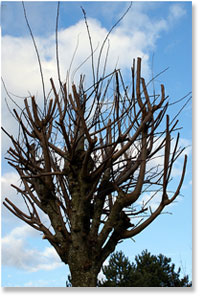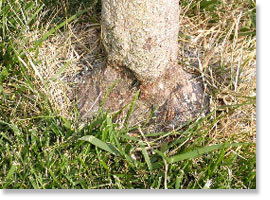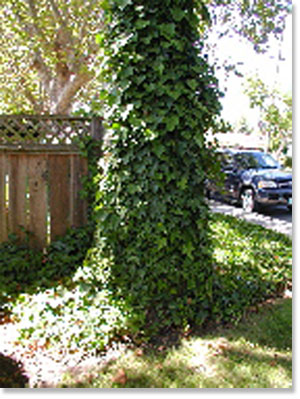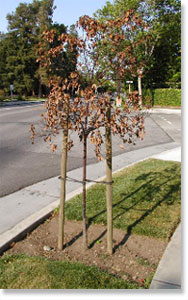- About Us
- Our Work
- Tree Info
- Get Involved
- Blog
- Support Us

Topping and other poor pruning techniques disfigure trees and make them susceptible to diseases and premature death. When pruning leaves behind stumps, trees are unable to compartmentalize the decay and heal over the wound, so fungus, bacteria and other pests/pathogens enter the heart of the tree and cause decay. Leaves produce the food for trees. When greater than 20% of a tree’s leaves are removed, the tree is unable to provide enough food, which results in root death and disease.

Mechanical damage is injury to the bark of a tree caused by weed whackers, lawn mowers, other lawn equipment, and bicycles or objects leaned against trees. These wounds are sometimes unable to heal if reinjured, making trees susceptible to diseases, and interrupting the transport of water and nutrients vital to the tree’s health.

Pruning or injuring trees that belong to the city or a neighbor is against California law, and and may result in a lawsuit against you for the full value of the tree and any loss of value to the neighboring property. This includes branches that come onto your property. If branches are not pruned properly and the tree is disfigured or mortally wounded, then you may also be liable.

Planting the wrong tree in the wrong place can lead to serious problems. For example, planting a tall tree under power lines results in a tree that must be topped by utility crews. This is costly for the city and all rate payers. It is also a loss of investment in a mature tree that can’t be pruned properly and will result in a misshapen and unhealthy tree. Palo Alto’s Right Tree Right Place program allows for free removal and replacement of trees interfering with power lines.

Competing lawn, weeds or plants growing around the base of the tree compete with the tree for moisture and nutrients. They also create shelter for insects and animals that chew on the bark and girdle the tree, leading to mechanical damage by lawn maintenance equipment.

Underwatering trees not only affects their long term health and growth, it can kill them. Young trees, particularly those under five years old, are very vulnerable.